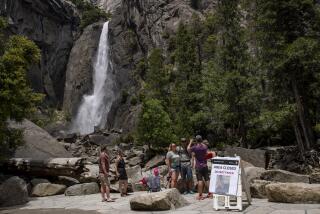Yosemite needs its plan back
- Share via
HOW MANY people can you allow into Yosemite Valley at one time and still make it an enjoyable experience? You might as well ask how many angels can dance on the head of a pin.
The seven-mile-by-one-mile valley is the core of Yosemite National Park and one of the natural wonders of the world. More than 3 million people visit Yosemite each year. On a busy summer day, the valley alone may have as many as 6,000 visitors, with 4,500 staying overnight in accommodations ranging from dusty campsites to the luxury Ahwahnee Hotel.
But the question of how many visitors and visitor services are enough -- or too much -- has halted the continued implementation of a management plan that was years in the making, as well as needed redevelopment. A federal court order has forced the park to put on hold a plan that was working and embark on a new, three-year planning process at the cost of hundreds of thousand dollars. It’s time for the courts to put a stop to more years of unnecessary planning and searching for an illusive number called “user capacity” for the valley.
The battle involves competing environmental protection organizations, with a small coalition composed of Friends of Yosemite Valley and Mariposans for the Environment and Responsible Government on one side versus an array of mainstream organizations including the Wilderness Society, the National Parks Conservation Assn., the Yosemite Fund and the American Alpine Club on the other side.
Friends of Yosemite Valley and its allies have repeatedly sued the National Park Service in an effort to strictly limit the number of visitors to the valley and the tourist services there. The mainstream groups, often park service adversaries in the past, are now joined in defense of Yosemite authorities.
The concept of limiting visitation has been debated for years. The law that established the National Park Service in 1916 itself is somewhat ambiguous. It declared that the purpose of the agency is to both “conserve the scenery and the natural and historic objects and the wildlife therein and to provide for the enjoyment of the same in such manner and by such means as will leave them unimpaired for the enjoyment of future generations.”
That can be a delicate juggling act and may vary from park to park. Since the early 1980s, with a revision in 1997, Yosemite had been guided by a general management plan, which sought to move many buildings and employee housing outside of the valley and to limit auto traffic largely by encouraging motorists to use a free shuttle service. Not everyone agreed with the outcome, but the vetting process was extensive. Generally it has been successful and served the purposes of the 1916 law. Still, a few purists deride any development in the valley as another Disneyland.
The current impasse has its beginnings in 1987, when Congress included 81 miles of the Merced River in Yosemite in the national system of wild and scenic rivers, thereby requiring Yosemite officials to draft a separate river protection plan. Further complicating matters was a flood in 1997 that wiped out a number of lodging and employee housing units and campgrounds. After the flood, a revised valley plan superseded portions of the 1980s general plan. Congress appropriated $200 million to repair destroyed areas and to rebuild some of the damaged buildings in line with the new plan.
Friends of Yosemite -- seeing a new opportunity to stop any renovations -- objected and filed a lawsuit, claiming that Yosemite officials had not drafted an acceptable river plan. But the group’s key objection was the lack of a visitor limit. Whether the Wild and Scenic Rivers Act requires such a cap is in dispute.
The plaintiffs also attacked the widening of El Portal Road -- washed out in the flood -- claiming that this allowed in tour buses and large recreation vehicles and that the revised valley plan provided for an increase in visitor lodging. But the unsafe, old, 9 1/2 -foot-wide highway was widened to just 11 feet -- still narrower than the national highway standard of 12 feet. And buses were already entering the park. Further, the 1997 revision reduced the number of rooms at Yosemite Lodge from 495 before the flood to 245.
The federal district court in Fresno upheld most of the plan, but after appeals, the U.S. 9th Circuit Court of Appeals ruled the plan deficient in two respects: a failure to adequately address user capacity and improper drawing of river boundaries. The district court subsequently halted renovations and ordered the park service to draft a new Merced River plan. The park service appeal is set to be heard in October.
The idea of limiting visitors to Yosemite is a debate without end. The court should put a stop to this folly and allow the valley plan to go forward.
More to Read
Sign up for The Wild
We’ll help you find the best places to hike, bike and run, as well as the perfect silent spots for meditation and yoga.
You may occasionally receive promotional content from the Los Angeles Times.






